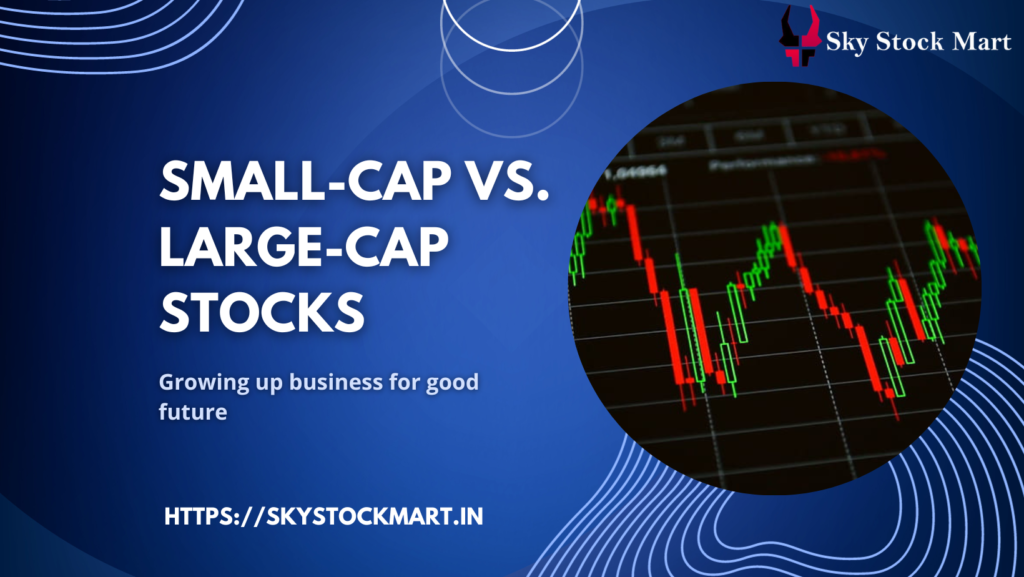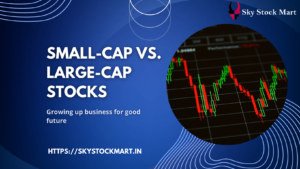Small-Cap vs. Large-Cap
Introduction
Investing in the stock market is an exciting journey that offers various avenues for growth. Two significant categories of stocks that often capture investors’ attention are small-cap and large-cap stocks. These terms refer to the market capitalization of a company, which can have a substantial impact on your investment strategy. In this blog, we will explore the differences between small-cap and large-cap stocks and help you navigate market trends for potential growth opportunities.
स्टॉक मार्केट ट्रेडिंग के लिए निःशुल्क डीमैट खाता खोलें
Small-Cap vs. Large-Cap Understanding Small-Cap and Large-Cap Stocks
Before diving into the strategies, let’s clarify what small-cap and large-cap stocks are:
- Small-Cap Stocks: Small-cap stocks typically belong to companies with a smaller market capitalization, often ranging from a few hundred million dollars to a few billion dollars. These companies are considered to have high growth potential but may also carry higher risks due to their size and volatility.
- Large-Cap Stocks: Large-cap stocks, on the other hand, are issued by well-established companies with significant market capitalization, often exceeding billions of dollars. These companies are generally more stable, pay dividends, and may have slower but consistent growth compared to small-caps.
-
स्टॉक मार्केट ट्रेडिंग के लिए निःशुल्क डीमैट खाता खोलें
Navigating Market Trends for Growth
Now, let’s explore how to navigate market trends for growth using both small-cap and large-cap stocks:
Small-Cap vs. Large-Cap bStocks for Explosive Growth
- Diversification: Small-cap stocks can provide diversification benefits, as they often behave differently from large-caps. Adding them to your portfolio can reduce overall risk.
- Innovation and Growth Potential: Smaller companies often have innovative ideas and the potential for rapid growth. If you can identify the right small-cap stocks, they can become your portfolio’s growth engine.
- Research and Due Diligence: Due to their higher risk, thorough research and due diligence are essential when investing in small-cap stocks. Investigate their financials, management team, and competitive positioning.
- Long-Term Approach: Small-cap investments may require patience. A long-term approach can help you weather market volatility and realize the full potential of your investments.
स्टॉक मार्केट ट्रेडिंग के लिए निःशुल्क डीमैट खाता खोलें
Small-Cap v s. Large-CapStocks for Stability and Dividends
- Stability and Consistency: Large-cap stocks often provide stability and consistency in a portfolio. They are less susceptible to economic downturns and can serve as a solid foundation for your investments.
- Dividend Income: Many large-cap companies pay dividends to shareholders. These dividends can provide a steady income stream and help offset potential losses during market downturns.
- Market Leadership: Large-cap companies are often industry leaders with well-established brands and market dominance. They tend to be more resilient during economic challenges.
- Risk Mitigation: Including large-caps in your portfolio can help mitigate risk during market turbulence, as their stability can counterbalance the volatility of small-caps.
-
स्टॉक मार्केट ट्रेडिंग के लिए निःशुल्क डीमैट खाता खोलें
Small-Cap vs. Large-Cap Balancing Your Portfolio
To navigate market trends effectively, consider balancing your portfolio with a mix of both small-cap and large-cap stocks. This diversification strategy can provide you with the best of both worlds: growth potential and stability. Additionally, continually monitor your investments and adjust your portfolio based on changing market conditions and your financial goals.
स्टॉक मार्केट ट्रेडिंग के लिए निःशुल्क डीमैट खाता खोलें
Small-Cap vs. Large-Cap Conclusion
Investing in small-cap and large-cap stocks can be a strategic approach to achieving your financial goals. Small-caps offer growth potential but come with higher risk, while large-caps provide stability and dividends. By understanding the differences between these two categories and balancing your portfolio accordingly, you can navigate market trends for potential growth while managing risk effectively. Remember that all investments carry some level of risk, so it’s essential to do your research and consider consulting with a financial advisor to align your investments with your financial objectives and risk tolerance.





